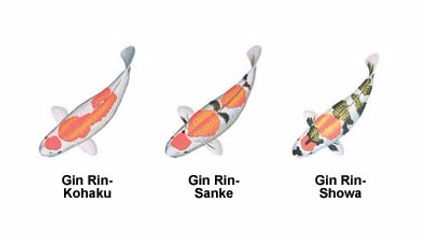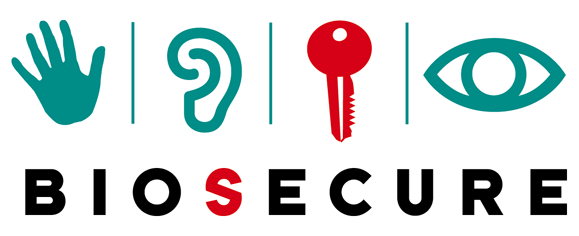Koi Varieties
Kohaku
Kohaku are still the most popular koi variety in Japan and potentially the most valuable. One of the most quoted phrases in koi keeping is that the hobbyist begins with Kohaku and ends with Kohaku. In fact, many new hobbyists overlook the Kohaku in preference for the brightly colored Ogon and other metallic koi because they feel that Kohaku look too much like goldfish! However, as they begin to appreciate the colors and patterns of koi, hobbyists often turn to Kohaku because of their simplicity and elegance.
Kohakus are white koi with red (hi) markings. Ideally, the hi should have a good depth of color but, more importantly, the color should be of a uniform shade and the edge of the hi pattern should be well defined. This definition between white and hi markings is known as "kiwa". There appear to be two types of coloration. The purplish red hi is dark and does not fade easily. This color is considered to lack elegance and tends to splatter over the koi. Brownish red hi can produce a very fine, almost translucent, color but tends to fade easily. The white should be the color of fresh snow and free from blemishes. A poor white, which can be dirty yellow in appearance, will spoil an otherwise good Kohaku because the hi pattern will not stand out.The unity and balance of color and pattern on a Kohaku are of the utmost importance. As a general guideline, the hi should cover between 50 and 70 percent of the koi.
Taisho Sanshoku (Sanke)
'Taisho Sanshoku', or 'sanke' is the term applied to a koi that has a white body with red and black markings. The black markings are in the form of spots that are generally confined to the body above the lateral line. Sanke as a koi breed was established around 1917.
The shiro (white) base color of the body must be unblemished, thick, snowy, and even milky. The shiro must not exhibit any yellowish tint. The hi (red) markings on the white body must be solid, deep, and evenly-colored throughout the entire body. The edges of these markings (also known as the 'kiwa') must be very defined, or as they say, 'sharp as a razor.'
The hi color may vary from koi to koi, but it should be of uniform hue within an individual koi. Different koi exhibit different hues, from a deep persimmon orange to dark, purplish red. This entire range is acceptable, although judges invariably have their own preferences. The sumi (black) markings of a Sanke must be deep, solid, and shiny lacquer-black. The shape of every sumi spot must be clearly defined, with its kiwa or edges as sharp as possible. Undeveloped sumi (also known as 'sashi') may appear mottled dark blue or gray instead of solid black. This is not bad for a young koi, since sumi actually develops as the koi grows older. In fact, spotting a potential champion at a young age involves good anticipation of how well the sumi will develop in the next few years.
A round patch of red on the head is considered nice. If this red patch is the only red marking on the sanke, then the koi is called a 'tancho sanke', a highly-prized koi variety among the Japanese since it looks like their national bird. If there are other red markings on the body of the koi, then the round head patch makes it a 'maruten' sanke.
The sumi of a sanke must be distributed in the koi body such that they collectively add balance to the koi. Their presence should enhance the 'kohaku pattern' and not degrade it. Old-style sanke koi are heavily endowed with sumi. Modern sanke exhibit a sparser distribution of sumi, but these should be clearly defined and solid black nonetheless. Koi experts also prefer sumi spots that are positioned over the white body. Conversely, sumi spots over hi markings are less desirable to them.
Showa Sanshoku (Showa)
'Showa Sanshoku', or 'showa' is the term applied to a koi that has a black body with red and white markings. This definition is confusing to beginners, since modern showa clearly shows that it also has a white body with red and black markings, just like a sanke. This definition came from the early history of showa. When this breed emerged and was established, it was predominantly black. At that time, most breeders keep this breed for its 'blackness.' Nowadays, hobbyists prefer a more balanced mix of red, white, and black.
The difference between a sanke and a showa is in the appearance of the sumi markings. Sanke sumi tend to be in the form of spots generally confined to the body above the lateral line, while showa sumi appear to be relatively larger streaks that 'wrap' around the body (going below the lateral line) as well as extend into the head. Showa as a koi breed was established around 1920, during the Showa Emperor Era.
The shiro (white) base color of the body must be unblemished, thick, snowy, and even milky. The shiro must not exhibit any yellowish tint. The hi (red) markings on the white body must be solid, deep, and evenly-colored throughout the entire body. The edges of these markings (also known as the 'kiwa') must be very defined, or as they say, 'sharp as a razor.'
The hi color may vary from koi to koi, but it should be of uniform hue within an individual koi. Different koi exhibit different hues, from a deep persimmon orange to dark, purplish red. This entire range is acceptable, although judges invariably have their own preferences. The sumi (black) markings of a Showa must be deep, solid, and shiny lacquer-black. The shape of every sumi marking must be clearly defined, with its kiwa or edges as sharp as possible. Undeveloped sumi may appear mottled dark blue or gray instead of solid black. This is not bad for a young koi, since sumi actually develops as the koi grows older. In fact, spotting a potential champion at a young age involves good anticipation of how well the sumi will develop in the next few years.
Doitsu
'Doitsu' is the term applied to a koi that either has no scales at all; or has scales only along the dorsal fin and maybe along the lateral line as well. Doitsu came about from the cross-breeding of Japanese koi with the German 'leather' carp, which doesn't have scales. As such, almost all koi breeds have their own 'doitsu' version.
Kin Gin Rin
'Kin Gin Rin' is the term applied to a koi whose scales exhibit a sparkling effect. 'Kin gin rin' translates to 'gold and silver scales'. A koi with only shining silver scales is referred to as 'ginrin', while one with only shining golden scales is referred to as 'kinrin'. All varieties of koi can have sparkling scales, so each koi variety has kinginrin variants or specimens.
A chemical deposit in the scales of the koi make them 'sparkle.' Sparkling scales were first discovered in 1929 and was called 'gingoke' by Esaburo Hochino.
Goshiki
'Goshiki' is the term applied to a koi that has a white base color with black-and-blue reticulation, overlaid by Kohaku-like red patterns. Reticulation refers to scales that form a net-like appearance.
Hikari Utsuri
'Hikari Utsuri' is the term applied to the metallic version of the Showa and Utsuri. The term 'hikari' translates to 'metallic.' This koi class includes the Kin Showa (metallic Showa with a golden shine), the Gin Showa (metallic Showa with a silver shine), the Gin Shiro (metallic Shiro Utsuri), the Kin Ki Utsuri (metallic Ki Utsuri), and the Kin Hi Utsuri (metallic Hi Utsuri).
Hikarimoyo
'Hikari Mujimono', or simply 'Hikarimuji', is the term applied to a metallic koi of single color. The term 'hikari' translates to 'metallic.' Examples of hikarimuji koi are the platinum ogon or purachina, the yamabuki ogon (light yellow), and the orenji ogon (orange).
Hikari Mujimono
Metallic koi that have more than one colour, but are not of Utsuri lineage, generally fall into this class. Hikarimoyo-mono derivation comes from two sources. One being Platinum Ogon crossed with many other varieties - except Utsuri, resulting in varieties such as Gin Bekko and Kujaku. The other group consisting of two colours - platinum, gold or orange - collectively known a Hariwake.. Examples are Orenji Hariwake and Hariwake Matsuba.
Kage
Kage translates as ‘shadow’ this describes the shadow effect on the edge of the koi’s scales.
Asagi
'Asagi' is the term applied to a fully reticulated koi that exhibits a blue color above its lateral line, and accented by red markings on its underside. Reticulation refers to scales that form a net-like appearance. Thus, an asagi exhibits a bluish net pattern all over the top portion of its body. This reticulation is created by the asagi's blue scales which are surrounded by white edges.
Koromo
'Koromo', which translates to 'robed', is the term applied to a koi that has a white base color, overlaid by red patterns with reticulation. Reticulation refers to scales that form a net-like appearance. In the case of Koromo, these net-like patterns are created by the blue edges of the scales over the red markings. Koromo is basically a cross between Kohaku and Asagi.
Bekko
'Bekko' is the term applied to a koi that has a single base color of white (shiro bekko), or red (aka bekko), or yellow (ki bekko). Over this base color are black markings in the form of spots generally confined to the body above the lateral line.
Bekko is to sanke as utsuri is to showa. Thus, all criteria that apply to sanke sumi quality and pattern are applicable to bekko sumi.
Chagoi
Cha-goi are part of the Kawarimono class. "Cha" means brown, or tea-coloured. Cha-goi are single coloured, nonmetallic koi which is said to be extremely fast growing. Although this variety seems quite plain at first glance, the reticulated scalation is quite attractive. There is also a Gin Rin variety which is appealing to most koi keepers. Cha-goi are one of the most easily tamed of all koi and a pleasure to have in one's pond.
Tancho
'Tancho' is the term applied to a Kohaku, Sanke, or Showa whose only red marking is a round patch of red on the head. Tancho koi are highly-prized among hobbyists, especially the Japanese, because they resemble Japan's flag and national bird. No other red marking must appear anywhere else. The red patch must be as round as possible, and should not reach the shoulder nor the nose of the fish.
Utsuri
'Utsuri' is the term applied to a koi that has a single base color of white (shiro utsuri), or red (hi utsuri), or yellow (ki utsuri). Over this base color are black markings that 'wrap' around the body (going below the lateral line) as well as extend into the head. Utsuri is to showa as bekko is to sanke. Thus, all criteria that apply to showa sumi quality and pattern are applicable to utsuri sumi. Utsuri was established around 1925.
Kawarimono
'Kawarigoi' or 'Kawarimono' is the term applied to a koi that can not be classified into any of the standard koi types. Since this is a 'catch-all' category, a lot of established koi varieties fall under it.





















